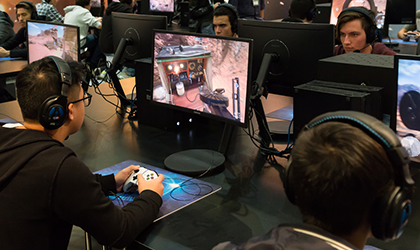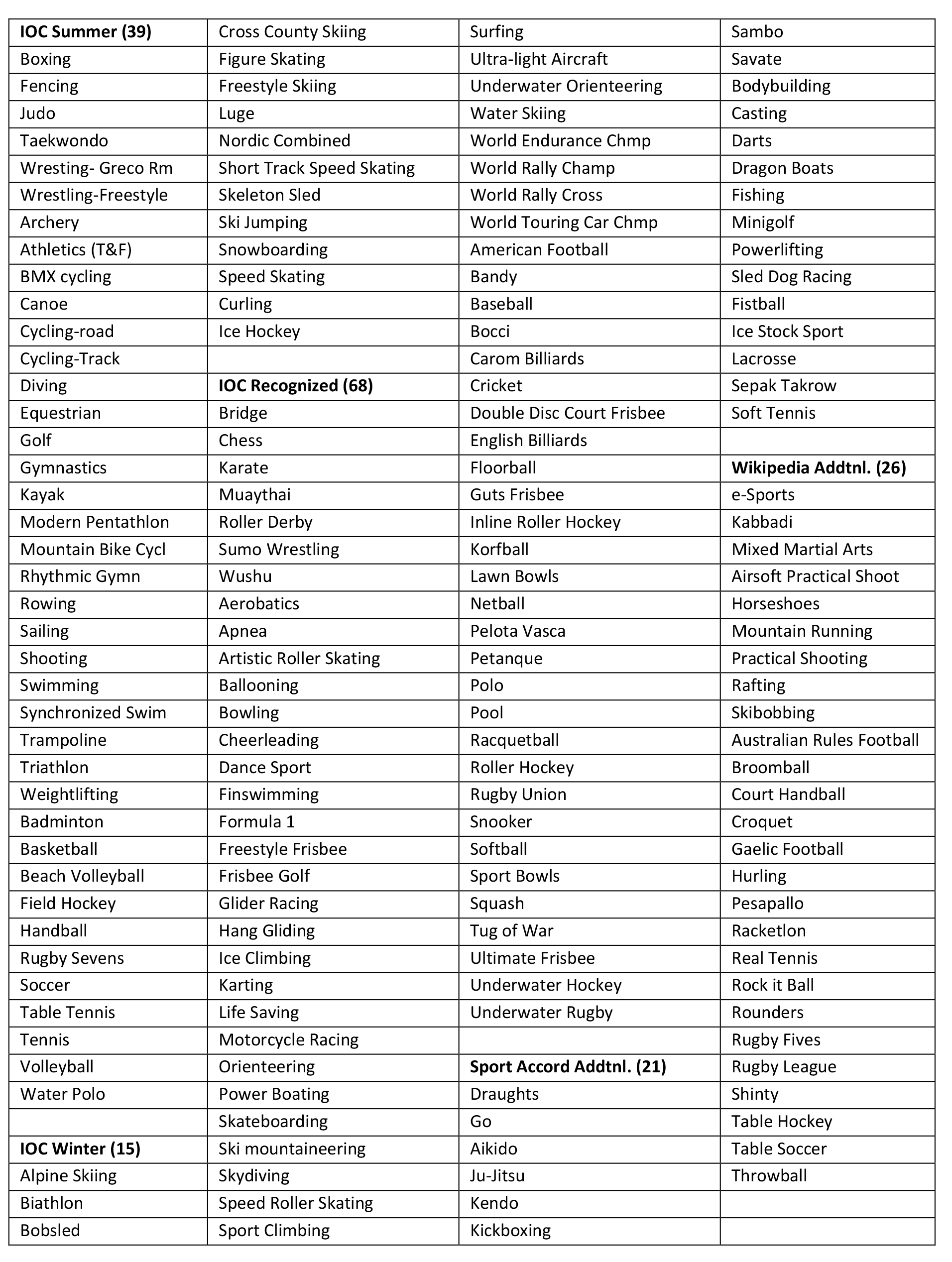
Most of us could describe a sport if asked. It might involve physical exertion of some kind – running, jumping, swimming – an element of competition, and a certain amount of blood, sweat and tears. But is the game of bridge a sport? Or chess? Both of these “mind sports” were included in the International Olympic Committee’s (IOC) list of recognized sports – a list of sports that could (but not necessary would) be featured in future Olympic Games. But what about video games?
To date there have been eight e-sports world championships, organized by the International e-Sports Federation, which enormously expanded video game competition from informal competitions in the neighbor’s den to international arenas, with local, TV and internet audiences claimed to be in the hundreds of millions. Should these audiences one day include the additional millions of Olympics-watchers? Should Starcraft II players one day compete for Olympic gold?
Contemporary society has obviously broadened the meaning of sport far beyond what IOC founder Baron de Coubertin could have imagined. We therefore need to be fair in our definition(s) of sport, rather than becoming provincial in disregarding any competition devoid of copious sweating and bleeding. But before we consider the future of sporting competition, we need to establish some precise definitions. We begin by asking: What is a sport, anyway?
Some suggested definitions
The Random House Dictionary of the English Language, Second Edition, Unabridged (1987) states that “a sport is an athletic activity requiring skill or prowess and often of a competitive nature”. The Random House Encyclopedia (1983) states that “a sport is an activity in which skill and physical prowess may be demonstrated. Generally, the term is restricted to a contest incorporating a specific set of rules.” Topend Sports states that “a sport is a human activity involving physical skill and exertion governed by a set of rules or customs undertaken competitively and capable of achieving a result”. The salient features of the three definitions may be combined compactly into a tentative definition of sport:
Sport: A sport is a competition with a set of rules for determining the winner, requiring physical prowess and skill.
Nowhere is the amount of power output (sweat) mentioned, nor is bleeding a pre-requisite. In other words, the above definition of sport has plenty of room for darts, swimming and boxing.
Next, we need to determine how “mind sports” like bridge and chess differ from the above tentative definition of sport. Although a mind sport competitor could not maintain focus and skill without some level of physical fitness, the main difference from the standard definition of sport is that the competitor is not judged or measured by the dexterity by which a chess piece is moved or the cards are held. Those nuances are captured as follows:
Mind Sport: A mind sport is a competition with a set of rules for determining the winner, requiring intellectual prowess and skill. A surrogate could move a playing piece or cards under direct control of the competitor.
We now must indicate how an e-sport differs from the above definitions. Although physical prowess and skill are required in an e-sport, instead of throwing a physical object or causing one’s own physical body to run, a virtual object or virtual person runs. That distinction leads to coining the term “physical sport” for a conventional sport and “e-sport” for the electronic newcomer.
Physical Sport: A physical sport is a competition with a set of rules for determining the winner, requiring physical prowess and skill to move the physical competitor and/or a physical object as required by the rules.
e-Sport: An e-sport is a competition with a set of rules for determining the winner, requiring physical prowess and skill to move a virtual person and/or a virtual object as required by the rules.
Recognized world sports
With these definitions to hand, we next consider the recognized “sports” of today. How may those sports be classified and what can we discern about the future for physical sports (in the Olympics) and for mind sports and e-sports? To answer those questions, we update, extend and interpret past studies of the taxonomy of sports1, collections of recognized sports with various classifications and rating systems2,3, and comments about the future of Olympic sports.4
Two organizations have cachet when it comes to acknowledging which sports are “sports”. The IOC is one; the other is Sport Accord, which recognizes all IOC sports as well as an important second-tier of sports. Sport Accord also organizes a number of international competitions for that second-tier. Sports are recognized via a two-step process. First, the IOC and Sport Accord recognize International Federations (IFs) that have demonstrated reliable and fair management practices. As a result, any sport organized by such a federation becomes a recognized sport. The IOC provides a convenient list of official Summer and Winter Olympic sports. The IOC also lists the recognized IFs for sports that are eligible for future Olympic inclusion. Sport Accord provides a list of the above federations as well as additional IFs that are considered noteworthy. Wikipedia lists all of the above, along with additional federations that are considered noteworthy. Major advantages of the above Wikipedia information are inclusiveness and the fact that, for each federation listed, each sport organized by that federation is also listed. To simplify this study, we will not include disabled sports. We have carefully examined the extra Wikipedia federations and eliminated those that have no workable link and those that do not demonstrate some level of international competition.
Thanks to Wikipedia, e-sports are included as one sport via the International e-Sports Federation (IeSF). According to the IeSF website, the following is the number of times each of 10 video games was used during the six IeSF world championships:
- Starcraft II (7)
- Hearthstone (4)
- League of Legends (4)
- Tekken Tag Tournament 2 (4)
- FIFA Online 2 (3)
- AVA (2)
- Warcraft 3 (2)
- Counter Strike: GO (1)
- DOTA 2 (1)
- Ultra Street Fighter 4 (1)
From the sources above, we find a total of 169 international sports, tabulated by the source of recognition in Tables 1 and 2, as of January 15, 2017. The physical sports are divided into three mutually-exclusive categories: “combat sports” in which each competitor tries to control the other, as in boxing and wrestling; “independent sports” in which there should be no (or only incidental) contact, such as swimming and rowing, and; “object sports” where the purpose of any activity is to control an object, as in basketball and soccer. The columns of Table 2 contain the 169 sports, listed by source of recognition. The sports, from top-to-bottom, are listed by category. For example, the first six of the 39 IOC summer Olympics sports are combat sports, followed by 22 individual sports and 11 object sports.
TABLE 1 Distribution of 169 significant international sports
 |
| TABLE 2 169 significant international sports by source of recognition and type of competition |
Of the 164 physical sports, the world-wide preference is reasonably balanced between independent sports (81) and object sports (64), far outweighing combat sports (19). On the other hand, Sport Accord has added to the IOC sports with a balanced collection of combat (6), individual (8), and object (5) physical sports as well as mind sports (2). There has been a major change in the current number of IOC non-Olympic recognized sports, compared to similar tables from November 2010, when there were about as many IOC recognized sports (53) as there were sports in the Olympics (54). In the last six years, the IOC has added 15 recognized sports, a 30% increase, bringing the total to 68. The nature of those 15 additional recognized sports is illustrative of IOC long-term planning: there are two combat sports (Muaythai and Roller Derby), 10 independent sports (including auto racing sports, Frisbee (flying disk) sports, skateboarding and cheerleading) and three object sports (including American football and Frisbee sports). The sports are strongly youth- and recreationally-oriented. Notice that there are now about as many recognized combat sports (5) as in the Olympics (6) and about as many recognized independent sports (32) as in the Olympics (35); but there are about twice as many recognized object sports (29) as in the Olympics (13). The IOC is showing preference for that latter category. The list of IOC recognized sports and recent IOC action gives us some guidance to the future of Olympic sports.
The future
Besides showing an interest in recognizing youth/recreationally-oriented physical sports, the IOC has significantly simplified the mechanism for an Olympic Organizing Committee (OOC) to add new sports taken from the list of IOC recognized sports.4 An OOC can now request a waiver to the limits on athletes and medal events in order to add new medal events for a specific Games, drawn from the ranks of sports offered by IOC-recognized federations. Approval was simplified to a majority vote of the IOC Executive Committee. The first test of that system came when all six sports requested for Tokyo 2020 were approved, including three “traditional” sports (baseball, softball and karate) as well as three highly youth-oriented sports (skateboarding, sport climbing and surfing). We can expect future OOCs to follow Tokyo’s lead and add recognized physical sports with many young and recreational adherents.
Indeed, the increasingly large number of young people involved in e-sports makes it plausible that the IOC will eventually add e-sports to its recognized list – and there is precedent for such a development. If we look to the Ancient Olympics as a guide, of the 833 events for which we have a reliable record spanning 776 BC to 277 AD5, we see that 4% (33 events) were for artistic performance. Most of those 33 were for the herald competition (12 events for yelling messages clearly over distance) and the trumpeter competition (19 events for trumpeting a message over a distance). Those skills were important due to the lack of loud speakers. A legendary (and apparently steel-lunged) trumpeter named Herodoros of Megara won nine consecutive times, spanning 32 years. The other two artistic performance events were contrived for Nero to win (in tragic acting and lyre playing: apparently, he did not “fiddle” while Rome burned, he played the lyre). As for the other 96%, 49% were in athletics, 32% were in combat sports, 11% were in chariot racing and 4% were in equestrian racing.
Suppose that an open-minded and forward looking OOC wanted to add one mind sport for men and women and one e-sport for men and women to the Summer Olympics. Those four medals would add just over 1% to the current 300 medal events, leaving the other 99% for physical sports. Given that the reputation of the Ancient Olympics seems not to have been diminished by devoting 4% of the events to artistic performance, devoting 1% of the medals in some future Olympics would be a reasonable accommodation to those gifted in mind sports and e-sports.
About the author
Ray Stefani is an emeritus professor of engineering at the California State University, Long Beach
References
- Stefani, R.T. (1999) A Taxonomy of Sports Rating Systems, IEEE Trans. on System, Man and Cybernetics, Part A, (29) 1, Jan. 1999, 116-120. ^
- Stefani, R.T. (2010) A World of Sports and Rating Systems, Proceedings of The Tenth Australasian Conference on Mathematics and Computers in Sport, July 5-7, 2010, Darwin, Australia. http://www.anziam.org.au/Tenth+MCS. ^
- Stefani, R.T. (2011) The Methodology of Officially Recognized International Sports Rating Systems, Journal of Quantitative Analysis in Sports. (7) 4, Article 10. ^
- Stefani, R.T. (2016a) Olympic Sports of the Future, The Sport Journal, March 30, 2016, http://thesportjournal.org/article/olympic-sports-of-the-future/. ^^
- Stefani, R.T. (2016b) Ancient Olympics: Events, Superstars, Cheating, Technology and Women’s Role, Proceedings of the 13th Australasian Conference on Mathematics and Computers in Sport, Melbourne Australia, 11-13 July 2016. http://www.anziam.org.au/Thirteenth+MCS ^



